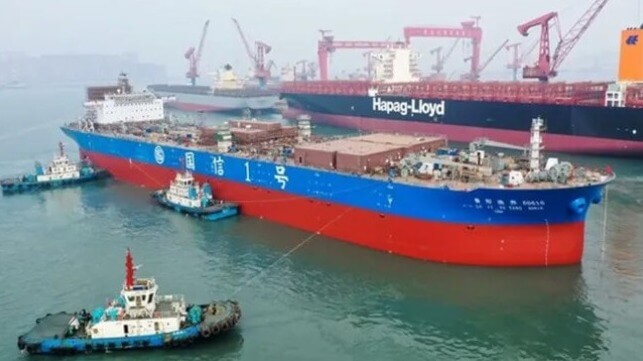China Delivers First Tanker-Sized Aquaculture Vessel

China celebrated the delivery today of the first of a new class of vessels which they report will revolutionize farm-raised fish with new methods of aquaculture. The size of an oil tanker, Guoxin 1 is a 100,000 dwt vessel that China boasts will yield over 3,700 tons of fish annually. Qingdao Guoxin Development Group which will be operating the vessel plans to build four ships after having proven some of its concepts on a smaller vessel and ultimately plans for a fleet of 50 floating, mobile fish farms.
Construction on the first vessel, Guoxin 1 started at CSSC’s Qingdao Beihai Shipbuilding in December 2020. The vessel measures 816 feet in length with 15 tanks twice the size of normal pools. It has nearly 900,000 square feet or over 19 acres, of capacity in the tanks. Among the challenges in the design and construction of the vessel were controlling both the sound levels aboard and vibration. Details were not provided on the propulsion system or speed of the vessel.
Guoxin 1 was launched from the shipyard in January 2022 and from April 30 to May 5 completed her sea trials. CSSC says it exceeded plans and was delivered with an official naming ceremony today, May 20. CSSC reports that it has applied for more than 40 patents, including one international patent, and obtained more than 10 authorizations for design elements.
CSSC proposed the concept and a demonstration project for deep-sea aquaculture in 2019. They are saying that the vessel achieved several records including becoming the largest aquaculture vessel, the larger tanks, and the greater aquaculture volume.
The core of the system is a constant exchange of water between the tanks and the sea that makes the water environment on the ship enclosed and controllable. The controlled environment permits them to isolate the fish from harmful natural disasters ranging from “red tide” and typhoons as well as pollution. Operations aboard the ship are monitored with underwater cameras, sensors, and an auto-feeding system as well as connectivity to the company’s onshore offices to monitor the fish.
They expect that they will be able to increase the density of the breeding operation three to five times higher than traditional cages and will be able to shorten the aquaculture cycles by up to a quarter. They also predict that the survival rate for the fish will be improved and that the weight gain rate will be increased. The focus will be on “high-quality cultured fish,” species such as yellow croaker, Atlantic salmon, and grouper. There was no information on how many people will be required to operate the ship or where it will operate.
Two identical ships, Guoxin 2 and Guoxin 3, are reportedly already under construction and due for delivery by March 2024. The fourth ship will be an “improved version” for which they plan to start construction in late 2023.
